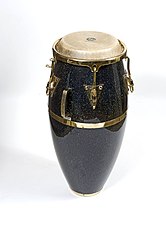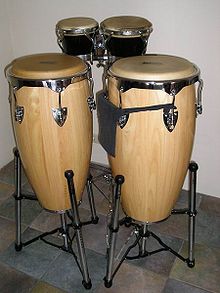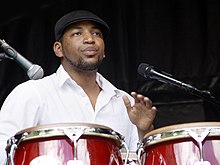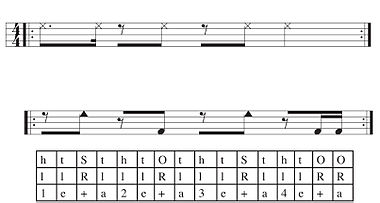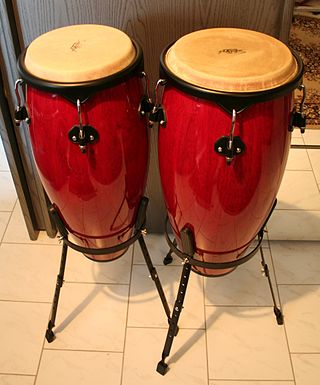
Salsa music is a style of Latin American music, combining elements of Cuban, Puerto Rican, and American influences. Because most of the basic musical components predate the labeling of salsa, there have been many controversies regarding its origin. Most songs considered as salsa are primarily based on son montuno and son cubano, with elements of guaracha, cha-cha-chá, danzón, descarga, bolero, guajira, rumba, mambo, jazz, funk, R&B, rock, bomba, and plena. All of these elements are adapted to fit the basic Son montuno template when performed within the context of salsa.
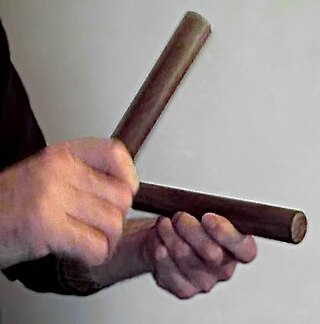
The clave is a rhythmic pattern used as a tool for temporal organization in Brazilian and Cuban music. In Spanish, clave literally means key, clef, code, or keystone. It is present in a variety of genres such as Abakuá music, rumba, conga, son, mambo, salsa, songo, timba and Afro-Cuban jazz. The five-stroke clave pattern represents the structural core of many Cuban rhythms. The study of rhythmic methodology, especially in the context of Afro-Cuban music, and how it influences the mood of a piece is known as clave theory.
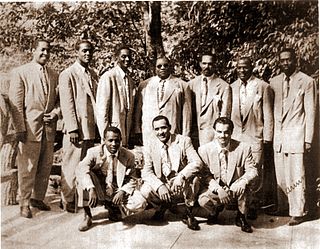
Arsenio Rodríguez was a Cuban musician, composer and bandleader. He played the tres, as well as the tumbadora, and he specialized in son, rumba and other Afro-Cuban music styles. In the 1940s and 1950s Rodríguez established the conjunto format and contributed to the development of the son montuno, the basic template of modern-day salsa. He claimed to be the true creator of the mambo and was an important as well as a prolific composer who wrote nearly two hundred songs.

Bongos are an Afro-Cuban percussion instrument consisting of a pair of small open bottomed hand drums of different sizes. The pair consists of the larger hembra and the smaller macho, which are joined by a wooden bridge. They are played with both hands and usually held between the legs, although in some cases, as in classical music, they may be played with sticks or mounted on stands.
Mozambique refers to two separate styles of music.
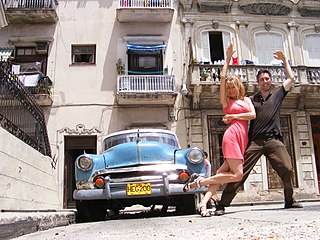
Timba is a Cuban genre of music based on Cuban son with salsa, American Funk/R&B and the strong influence of Afro-Cuban folkloric music. Timba rhythm sections differ from their salsa counterparts, because timba emphasizes the bass drum, which is not used in salsa bands. Timba and salsa use the same tempo range and they both use the standard conga marcha. Almost all timba bands have a trap drummer. Timbas also often break the basic tenets of arranging the music in-clave. Timba is considered to be a highly aggressive type of music, with rhythm and "swing" taking precedence over melody and lyricism. Associated with timba is a radically sexual and provocative dance style known as despelote. It is a dynamic evolution of salsa, full of improvisation and Afro Cuban heritage, based on son, Rumba and mambo, taking inspiration from Latin jazz, and is highly percussive with complex sections. Timba is more flexible than salsa and includes a more diverse range of styles. Timba incorporates heavy percussion and rhythms which originally came from the barrios of Cuba.
Los Muñequitos de Matanzas is a Cuban rumba ensemble from the city of Matanzas. The group was established in 1952 as Conjunto Guaguancó Matancero and released their first LP in 1956 through Puchito. Since then, Los Muñequitos have continued to perform and record, becoming one of the most successful and critically acclaimed rumba groups of all time.
Afro-Caribbean music is a broad term for music styles originating in the Caribbean from the African diaspora. These types of music usually have West African/Central African influence because of the presence and history of African people and their descendants living in the Caribbean, as a result of the trans-Atlantic slave trade. These distinctive musical art forms came about from the cultural mingling of African, Indigenous, and European inhabitants. Characteristically, Afro-Caribbean music incorporates components, instruments and influences from a variety of African cultures, as well as Indigenous and European cultures.
Guaguancó is a subgenre of Cuban rumba, combining percussion, voices, and dance. There are two main styles: Havana and Matanzas.
The term conga refers to the music groups within Cuban comparsas and the music they play. Comparsas are large ensembles of musicians, singers and dancers with a specific costume and choreography which perform in the street carnivals of Santiago de Cuba and Havana.
Songo is a genre of popular Cuban music, created by the group Los Van Van in the early 1970s. Songo incorporated rhythmic elements from folkloric rumba into popular dance music, and was a significant departure from the son montuno/mambo-based structure which had dominated popular music in Cuba since the 1940s. Blas Egües was the first drummer in Los Van Van, but it was the band's second drummer, José Luis Quintana "Changuito", who developed songo into the world-wide phenomenon it is today.
Yuka is a secular Afro-Cuban musical tradition which involves drumming, singing and dancing. It was developed in western Cuba by Kongo slaves during colonial times. Yuka predates other Afro-Cuban genres of dance music like rumba and has survived in Kongo communities of Pinar del Río, specifically in El Guayabo and Barbacoa, San Luis. Since the 1940s, yuka performances have been recorded by researchers such as Harold Courlander and María Teresa Linares.
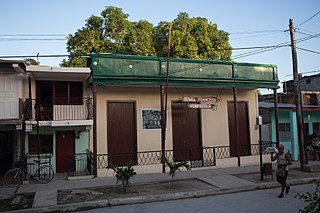
Tumba francesa is a secular Afro-Cuban genre of dance, song, and drumming that emerged in Oriente, Cuba. It was introduced by slaves from the French colony of Saint-Domingue whose owners resettled in Cuba's eastern regions following the slave rebellion during the 1790s. The genre flourished in the late 19th century with the establishment of sociedades de tumba francesa, of which only three survive.
The tumba, also known as a tumbadora or salidor, is a kind of long, thin, single-headed drum, whose pitch depends on the part of the head being hit. The tumba is the largest drum of the conga family, typically with a head about 12.5 inches in diameter. There is a super-tumba variant of the tumba that is even larger. Of Cuban origin, the tumba is traditionally a stave drum constructed in the same manner as a barrel with long, thin strips of wood, but can also be made out of fiberglass.

Rumba is a secular genre of Cuban music involving dance, percussion, and song. It originated in the northern regions of Cuba, mainly in urban Havana and Matanzas, during the late 19th century. It is based on African music and dance traditions, namely Abakuá and yuka, as well as the Spanish-based coros de clave. According to Argeliers León, rumba is one of the major "genre complexes" of Cuban music, and the term rumba complex is now commonly used by musicologists. This complex encompasses the three traditional forms of rumba, as well as their contemporary derivatives and other minor styles.
In music of Afro-Cuban origin, tumbao is the basic rhythm played on the bass. In North America, the basic conga drum pattern used in popular music is also called tumbao. In the contemporary form of Cuban popular dance music known as timba, piano guajeos are known as tumbaos.
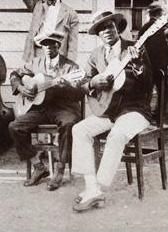
A guajeo is a typical Cuban ostinato melody, most often consisting of arpeggiated chords in syncopated patterns. Some musicians only use the term guajeo for ostinato patterns played specifically by a tres, piano, an instrument of the violin family, or saxophones. Piano guajeos are one of the most recognizable elements of modern-day salsa. Piano guajeos are also known as montunos in North America, or tumbaos in the contemporary Cuban dance music timba.
Tresillo is a rhythmic pattern used in Latin American music. It is a more basic form of the rhythmic figure known as the habanera.
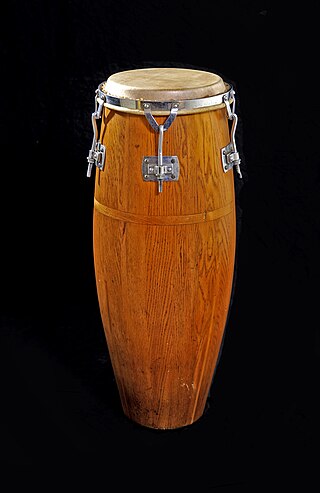
The quinto is the smallest and highest pitched type of conga drum. It is used as the lead drum in Cuban rumba styles such as guaguancó, yambú, columbia and guarapachangueo, and it is also present in congas de comparsa. Quinto phrases are played in both triple-pulse and duple-pulse structures. In columbia, triple pulse is the primary structure and duple pulse is secondary. In yambú and guaguancó duple-pulse is primary and triple-pulse is secondary.
The musical structure of Salsa (music) is composed of several components and sections.
